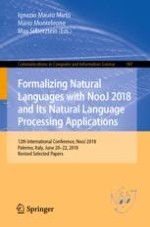This book constitutes the refereed proceedings of the 12th International Conference, NooJ 2018, held in Palermo, Italy, in June 2018.
The 17 revised full papers and 3 short papers presented in this volume were carefully reviewed and selected from 48 submissions. NooJ is a linguistic development environment that provides tools for linguists to construct linguistic resources that formalize a large gamut of linguistic phenomena: typography, orthography, lexicons for simple words, multiword units and discontinuous expressions, inflectional and derivational morphology, local, structural and transformational syntax, and semantics. The papers in this volume are organized in topical sections on vocabulary and morphology; syntax and semantics; and natural language processing applications.
